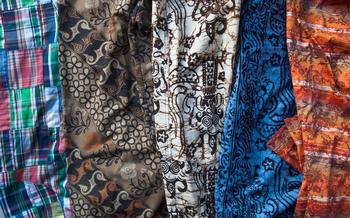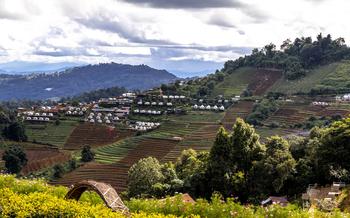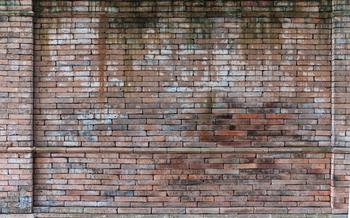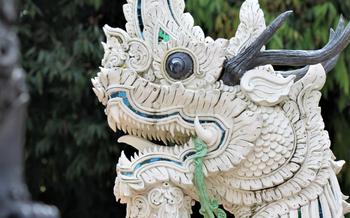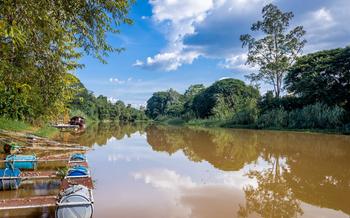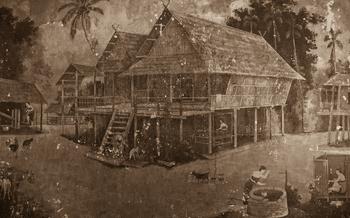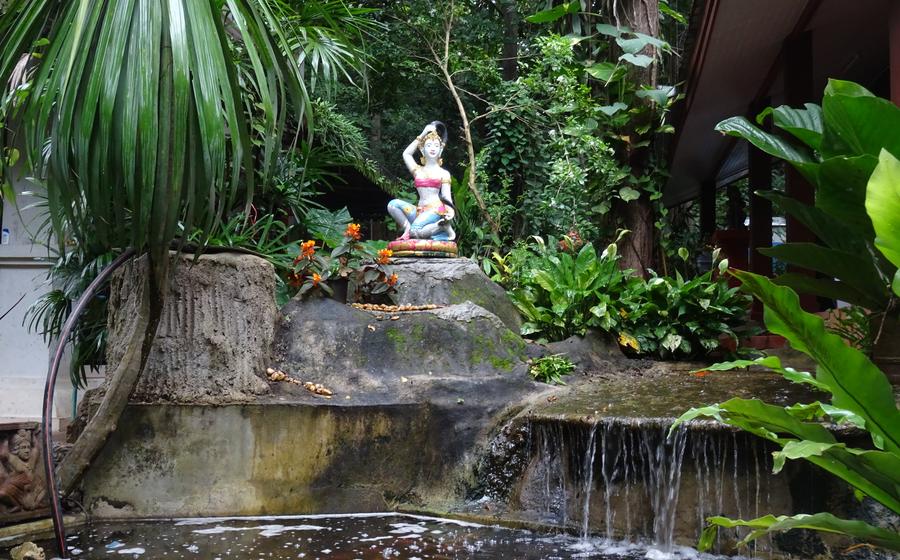
Wat Umong
- Wat Umong: A Serene Temple in Chiang Mai's Backyard
- Exploring the Tunnels and Underground Chambers
- Marveling at the Forest Surroundings
- Paying Respect at the Buddha Images
- Learning About the Resident Monks
- Taking a Meditation Retreat
- Attending a Buddhist Ceremony
- Joining a Cooking Class
- Visiting the Handicraft Market
- Trying Local Street Food
- Visiting Nearby Attractions
- Staying Overnight at Wat Umong
- Getting Around Wat Umong: Navigating the Temple's Grounds
- Planning Your Visit
Wat Umong: A Serene Temple in Chiang Mai's Backyard
Nestled amidst the lush forests of Doi Suthep, Wat Umong is a hidden gem that offers a serene retreat from the bustling city of Chiang Mai. This ancient temple, dating back to the 13th century, is steeped in history and exudes a mystical aura that attracts visitors from all over the world.
Wat Umong's unique features set it apart from other temples in the region. Its most striking characteristic is the network of tunnels and underground chambers that honeycomb the temple grounds. These tunnels, dug by hand by Buddhist monks centuries ago, serve as a place for meditation and spiritual contemplation. Visitors can explore these tunnels, marveling at the intricate carvings and Buddha images that adorn the walls.
The natural beauty of the surrounding forest adds to the allure of Wat Umong. Visitors can stroll through the forest, taking in the diverse flora and fauna, and enjoying the peace and tranquility of the natural surroundings. The forest holds a special significance in Thai culture and religion, as it is believed to be the dwelling place of spirits and deities.
Exploring the Tunnels and Underground Chambers
Wat Umong's subterranean tunnels and chambers are its most distinguishing and enigmatic feature. These tunnels were built in the 14th century as a place for meditation and religious practice. They stretch for over a kilometer and are a labyrinth of narrow passages, hidden chambers, and secret doors.
Exploring the tunnels is a unique and awe-inspiring experience. Visitors can wander through the dark and atmospheric passageways, discovering hidden chambers and niches along the way. Some of the chambers contain Buddha images, while others are decorated with intricate murals and carvings. The tunnels are a testament to the ingenuity and craftsmanship of the ancient builders.
It is important to note that the tunnels can be dark and narrow, so it is advisable to bring a flashlight and wear comfortable shoes. Visitors should also be aware of their surroundings and take care not to get lost. The tunnels are not suitable for people with claustrophobia or mobility issues.
For Buddhist monks, the tunnels have a deep spiritual significance. They are seen as a place of retreat and contemplation, where monks can come to escape the distractions of the outside world and focus on their spiritual practice. The tunnels are also believed to be a place of power and energy, and many monks meditate in the tunnels to harness this energy and deepen their spiritual connection.
Marveling at the Forest Surroundings
Wat Umong is surrounded by a lush forest that is home to a diverse array of flora and fauna. The forest is a haven for nature lovers, offering opportunities for hiking, birdwatching, and picnicking. Visitors can stroll along the forest trails, admiring the towering trees, colorful flowers, and exotic birds. The forest is also home to many small animals, such as squirrels, lizards, and monkeys.
The forest surrounding Wat Umong holds deep significance in Thai culture and religion. Forests are considered to be sacred places in Thailand, and they are often associated with Buddhism. In the Buddhist tradition, forests are seen as places of peace and tranquility, where one can go to meditate and connect with nature. The forest surrounding Wat Umong is a popular destination for Buddhist monks and laypeople alike who come to seek refuge from the hustle and bustle of everyday life.
There are many activities that visitors can enjoy in the forest surrounding Wat Umong. Hiking is a great way to explore the forest and see its many wonders. There are several trails to choose from, ranging from easy to challenging. Birdwatching is another popular activity, as the forest is home to a wide variety of birds. Visitors can also enjoy a picnic in the forest, surrounded by the sounds of nature.
It is important to respect the forest environment when visiting Wat Umong. Visitors should stay on the trails and avoid disturbing the wildlife. It is also important to dispose of trash properly and to be mindful of noise levels. By following these simple guidelines, visitors can help to protect the forest and ensure that it remains a place of peace and tranquility for generations to come.
Paying Respect at the Buddha Images
The Buddha images at Wat Umong are not just objects of worship, they are also repositories of spiritual energy and blessings. According to Buddhist beliefs, paying respect to Buddha images can bring good fortune, peace of mind, and protection from harm. It is also a way to show gratitude for the teachings of the Buddha and to connect with the divine.
Wat Umong is home to a diverse collection of Buddha images, ranging from small, intricate statues to large, imposing figures. Each Buddha image has its own unique story and significance. Some of the most popular Buddha images at Wat Umong include the Phra Buddha Sihing, a replica of the Emerald Buddha; the Phra Buddha Chinnarat, a highly revered Buddha image from the 15th century; and the Phra Buddha Metตา, a large, seated Buddha image that exudes peace and serenity.
When paying respect to a Buddha image, it is customary to bow three times and then make an offering. Offerings can be simple, such as flowers, incense, or candles. If you are not sure what to offer, you can ask a monk or another visitor for advice.
As you make your offerings, take a few moments to reflect on the Buddha's teachings and to pray for guidance and protection. You may also want to chant a mantra or recite a prayer. The most important thing is to be sincere in your devotion and to approach the Buddha images with a respectful and open heart.
Learning About the Resident Monks
Wat Umong is not just a historical site; it's also an active monastery, home to a community of Buddhist monks. The monks are an integral part of the temple's daily life and play a crucial role in preserving Thai Buddhist traditions. Visitors to Wat Umong have the unique opportunity to interact with the monks and learn about their way of life.
The monks at Wat Umong follow a strict daily routine that includes meditation, chanting, and studying Buddhist scriptures. They also spend time teaching and guiding visitors, offering insights into the principles and practices of Buddhism. Visitors can participate in meditation sessions, alms-giving ceremonies, and other activities that provide a glimpse into the monastic lifestyle.
Interacting with the monks is a rewarding experience for many visitors. The monks are known for their kindness, wisdom, and patience, and they are eager to share their knowledge and insights with others. Whether you're a seasoned Buddhist practitioner or simply curious about the religion, spending time with the monks at Wat Umong is a unique and enriching experience.
Here are some tips for interacting with the monks at Wat Umong:
- Always be respectful and mindful of the monks' time and space.
- Dress modestly and avoid wearing revealing or offensive clothing.
- Remove your shoes before entering the temple and sit in a respectful manner.
- Speak softly and avoid disturbing the monks during meditation or other religious activities.
- If you have any questions, feel free to ask the monks or a temple guide.
Taking a Meditation Retreat
Wat Umong is a renowned center for meditation, offering visitors the opportunity to learn and practice this ancient tradition in a serene and supportive environment. Meditation has numerous benefits for both physical and mental well-being, including reducing stress, improving focus, and cultivating inner peace.
There are several types of meditation offered at Wat Umong, including mindfulness meditation, loving-kindness meditation, and Vipassana meditation. Visitors can choose the type of meditation that best suits their needs and interests.
Before embarking on a meditation retreat at Wat Umong, it is essential to plan and prepare. This includes setting clear intentions for the retreat, choosing the right time of year (avoiding the rainy season), and packing appropriate clothing and supplies. It is also advisable to inform the temple of any dietary restrictions or health conditions.
During the retreat, participants will have the opportunity to learn from experienced meditation teachers, practice meditation techniques daily, and participate in group discussions and activities. The daily schedule typically includes meditation sessions, teachings, and breaks for meals and rest.
For those seeking a transformative experience, a meditation retreat at Wat Umong is an excellent opportunity to deepen their practice, connect with their inner selves, and find peace and tranquility in the heart of Chiang Mai's spiritual landscape.
Attending a Buddhist Ceremony
Attending a Buddhist ceremony at Wat Umong is an enriching and immersive experience that offers a glimpse into the heart of Thai culture and spirituality. These ceremonies are held on various occasions throughout the year, including festivals, holidays, and special events.
The most common type of ceremony is the daily morning chanting, which takes place in the main temple hall. During this ceremony, monks gather to chant scriptures and prayers in Pali, the ancient language of Buddhism. The chanting is accompanied by the rhythmic beating of drums and gongs, creating a mesmerizing atmosphere.
Visitors are welcome to attend these ceremonies and observe the monks in their devotional practice. It is important to be respectful and mindful of the sacred nature of the ceremony. Visitors should dress modestly, remove their shoes before entering the temple hall, and refrain from talking or making noise during the chanting.
In addition to the daily chanting, Wat Umong also hosts special ceremonies on important Buddhist holidays, such as Visakha Bucha Day, which commemorates the birth, enlightenment, and passing of the Buddha. These ceremonies often involve processions, offerings, and chanting, and are a vibrant display of Thai Buddhist culture.
Participating in a Buddhist ceremony at Wat Umong is a unique opportunity to connect with the local community, learn about Thai Buddhist traditions, and experience the spiritual essence of this sacred temple.
Joining a Cooking Class
Wat Umong offers a variety of cooking classes, allowing visitors to learn the art of Thai cuisine in a serene and spiritual setting. These classes are led by experienced chefs who share their knowledge of traditional Thai ingredients, techniques, and recipes.
Participants can choose from a range of classes, each focusing on different aspects of Thai cooking. Whether you're a beginner or an experienced cook, there's a class to suit your skill level and interests.
During the class, you'll learn how to prepare a variety of dishes, from classic pad thai and green curry to more intricate dishes like massaman curry and khao soi. You'll also learn about the history and cultural significance of Thai cuisine, as well as tips and tricks for cooking delicious Thai food at home.
The cooking classes at Wat Umong are a great way to immerse yourself in Thai culture and learn new skills. They're also a lot of fun, and you'll leave with a newfound appreciation for the flavors and aromas of Thai cuisine.
Tips for Joining a Cooking Class
- Book your class in advance, especially if you're visiting during peak season.
- Wear comfortable clothing and shoes, as you'll be doing a lot of standing and cooking.
- Bring a camera to capture your culinary creations.
- Be prepared to get messy! Thai cooking can be a hands-on experience.
- Enjoy the experience! Cooking Thai food is a great way to learn about the culture and make new friends.
Visiting the Handicraft Market
Nestled within the temple grounds, the lively handicraft market is a treasure trove of locally made souvenirs, clothing, and home goods. This vibrant market showcases the artistic talents of the local community and offers a unique opportunity to support their livelihoods.
From intricately carved wooden figurines to colorful hand-woven textiles, the variety of handicrafts on display is astounding. Visitors can find everything from delicate jewelry and decorative ceramics to unique pieces of furniture and home décor. Each item is crafted with care and attention to detail, reflecting the rich cultural heritage of the region.
Bartering is a common practice at the market, and visitors can enjoy the friendly banter with the vendors as they negotiate for the best prices. It's not just about the price, though; the market is also a place for cultural exchange and interaction. Visitors can learn about the artisans' techniques and inspirations, and gain insights into the local way of life.
By shopping at the market, visitors not only take home beautiful souvenirs but also contribute to the preservation of traditional Thai crafts and the economic well-being of the local community. It's a meaningful way to support local artisans and ensure that these skills continue to be passed down from generation to generation.
Trying Local Street Food
When exploring Wat Umong, don't miss the opportunity to savor the delectable street food that lines the temple's perimeter. The vibrant stalls, manned by local vendors, offer a tempting array of culinary delights that will tantalize your taste buds and immerse you in the vibrant food culture of Thailand.
From aromatic pad thai, a stir-fried rice noodle dish with a tangy tamarind sauce, to khao soi, a rich coconut-based curry noodle soup, the street food scene near Wat Umong is a haven for food enthusiasts. Indulge in the crispy fried chicken, succulent grilled meats, and refreshing fruit shakes that are sure to leave you craving more.
Remember to embrace the local custom of "mai pet", which means "not spicy," if you prefer a milder flavor profile. Be adventurous and try some of the unique and exotic offerings, such as gai yang, grilled chicken marinated in a flavorful blend of herbs and spices, or som tam, a spicy green papaya salad with a kick.
To ensure a safe and enjoyable street food experience, choose stalls that are popular with locals and maintain good hygiene practices. Look for vendors who use fresh ingredients and cook their food thoroughly. Don't forget to hydrate with plenty of water, as the Thai heat can be intense.
Immerse yourself in the vibrant atmosphere of the street food market, where the air is filled with the tantalizing aromas of sizzling woks and the friendly chatter of locals. Engage with the friendly vendors, who are always happy to share their culinary secrets and recommend their favorite dishes.
Indulging in local street food is not just about satisfying your taste buds; it's also a way to connect with the local culture and support the community. By sampling the diverse culinary offerings near Wat Umong, you'll gain a deeper appreciation for the rich gastronomic traditions of Thailand.
Visiting Nearby Attractions
Wat Umong is surrounded by a wealth of other attractions that visitors can explore, making it an ideal base for a longer stay in Chiang Mai. For those interested in history and culture, the nearby Wat Phra That Doi Suthep is a must-see. This revered temple is perched atop a mountain and offers stunning views of the surrounding countryside. Other notable temples in the area include Wat Chedi Luang, with its iconic ruined stupa, and Wat Sri Suphan, known for its silver temple.
Nature lovers will appreciate the many natural attractions near Wat Umong. The Doi Suthep-Pui National Park is home to lush forests, waterfalls, and hiking trails. The park is also home to several hill tribes, offering visitors a glimpse into their unique cultures. For a more relaxed experience, visitors can head to the nearby Mae Sa Waterfall, where they can cool off in the refreshing waters and enjoy the beautiful scenery.
In addition to temples and natural attractions, the area around Wat Umong is also home to several cultural attractions. The Sankampaeng Road Handicraft Village is a great place to find souvenirs and learn about traditional Thai crafts. The village is home to a variety of shops and workshops, where visitors can watch artisans create beautiful pottery, textiles, and other handicrafts. For a taste of local life, visitors can head to the nearby Chang Klan Night Market, where they can sample delicious street food and browse a variety of stalls selling everything from clothing to souvenirs.
Staying Overnight at Wat Umong
Wat Umong offers a unique opportunity for visitors to stay overnight within the temple grounds. This is a great way to experience the temple's serene atmosphere and immerse yourself in the Buddhist culture. There are several types of accommodations available, ranging from simple guesthouses to private bungalows.
The guesthouses are basic but comfortable, with shared bathrooms and common areas. The bungalows are more spacious and offer more privacy, with en-suite bathrooms and private balconies. Prices for accommodations start at around 200 baht per night for a guesthouse and 500 baht per night for a bungalow.
Staying overnight at Wat Umong is a truly special experience. You will have the chance to witness the temple's daily rituals and ceremonies, and interact with the resident monks. You will also have plenty of time to explore the temple's grounds and surrounding forest at your own pace.
To book accommodations at Wat Umong, you can contact the temple directly or book through a travel agent. It is important to book in advance, especially during peak season.
Here are some tips for planning your overnight stay at Wat Umong:
- Book your accommodations in advance, especially if you are traveling during peak season.
- Bring comfortable shoes and clothing, as you will be doing a lot of walking.
- Be respectful of the temple's environment and other visitors.
- Take advantage of the opportunity to interact with the resident monks and learn more about Buddhism.
- Allow yourself plenty of time to explore the temple's grounds and surrounding forest.
Getting Around Wat Umong: Navigating the Temple's Grounds
Exploring the vast grounds of Wat Umong requires careful navigation to ensure a smooth and enjoyable visit. The temple offers multiple options for getting around, catering to different preferences and abilities.
Strolling Through History: Exploring Wat Umong on Foot
Walking remains the most popular way to explore Wat Umong. The temple's well-maintained paths wind through lush gardens, past ancient stupas, and into hidden corners, inviting visitors to immerse themselves in the tranquil atmosphere. Comfortable shoes are highly recommended for navigating the uneven surfaces and numerous steps.
Biking Amidst Nature: A Refreshing Adventure
For those seeking a more active experience, bicycles are available for rent within the temple grounds. Cycling through the forest trails offers a refreshing escape from the heat and allows visitors to cover more ground, discovering hidden gems along the way.
Tuk-Tuk Rides: A Convenient Option for Exploring
For visitors who prefer a more leisurely approach, tuk-tuks, Thailand's iconic three-wheeled vehicles, are readily available within the temple. These colorful taxis can be hired for short distances or longer tours, providing a fun and convenient way to explore the temple's vast expanse.
Navigating with Ease: Maps and Signage
Wat Umong provides visitors with detailed maps and clear signage to help them navigate the temple grounds. These guides indicate the location of key attractions, such as the tunnels, Buddha images, and meditation centers, ensuring that visitors can easily find their way around.
Accessibility Considerations: Ensuring Inclusivity
Wat Umong strives to be accessible to visitors of all abilities. While some areas of the temple may require climbing stairs, ramps and alternative routes are available for those with mobility challenges. Visitors with disabilities are encouraged to inquire about accessible options upon arrival.
Respecting the Temple Environment: A Sacred Space
As visitors explore Wat Umong, it's essential to be mindful of the temple's sacred nature and respect the environment. Refraining from loud noises, littering, or damaging plants and structures is crucial for preserving the tranquility and beauty of this sacred space.
Planning Your Visit
When to Visit
The best time to visit Wat Umong is during the cool and dry season, which runs from November to February. During this time, the weather is pleasant for exploring the temple grounds and the surrounding forest. However, Wat Umong is a popular destination, so it can be crowded during peak tourist season. If you prefer a quieter experience, consider visiting during the shoulder months of March or October.
Pro tip: For the ultimate spiritual experience, try to visit Wat Umong during a Buddhist holiday, such as Visakha Bucha or Asalha Puja. These holidays are celebrated with special ceremonies and rituals, giving you a deeper insight into Thai Buddhist culture.
What to Wear and Bring
When visiting Wat Umong, it is important to dress respectfully. This means covering your shoulders and knees, and avoiding shorts or revealing clothing. You should also remove your shoes before entering any of the temple buildings.
Be sure to bring comfortable shoes, as you will be doing a lot of walking. You may also want to bring a camera to capture the beautiful scenery and architecture.
Tips for Avoiding Crowds
If you want to avoid the crowds, try to visit Wat Umong early in the morning or late in the afternoon. You can also visit during the week, as weekends tend to be busier.
Local customs and etiquette to be aware of: When visiting Wat Umong, it is important to be respectful of the temple and its inhabitants. This means speaking quietly, avoiding loud noises, and not touching any of the Buddha images. You should also refrain from taking photos of people without their permission.
